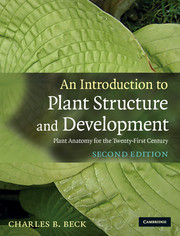Book contents
- Frontmatter
- Contents
- Preface to the second edition
- Preface
- Acknowledgements
- General references
- Chapter 1 Problems of adaptation to a terrestrial environment
- Chapter 2 An overview of plant structure and development
- Chapter 3 The protoplast of the eukaryotic cell
- Chapter 4 Structure and development of the cell wall
- Chapter 5 Meristems of the shoot and their role in plant growth and development
- Chapter 6 Morphology and development of the primary vascular system of the stem
- Chapter 7 Sympodial systems and patterns of nodal anatomy
- Chapter 8 The epidermis
- Chapter 9 The origin of secondary tissue systems and the effect of their formation on the primary body in seed plants
- Chapter 10 The vascular cambium: structure and function
- Chapter 11 Secondary xylem
- Chapter 12 The phloem
- Chapter 13 Periderm, rhytidome, and the nature of bark
- Chapter 14 Unusual features of structure and development in stems and roots
- Chapter 15 Secretion in plants
- Chapter 16 The root
- Chapter 17 The leaf
- Chapter 18 Reproduction and the origin of the sporophyte
- Glossary
- Index
- References
Chapter 5 - Meristems of the shoot and their role in plant growth and development
Published online by Cambridge University Press: 05 June 2012
- Frontmatter
- Contents
- Preface to the second edition
- Preface
- Acknowledgements
- General references
- Chapter 1 Problems of adaptation to a terrestrial environment
- Chapter 2 An overview of plant structure and development
- Chapter 3 The protoplast of the eukaryotic cell
- Chapter 4 Structure and development of the cell wall
- Chapter 5 Meristems of the shoot and their role in plant growth and development
- Chapter 6 Morphology and development of the primary vascular system of the stem
- Chapter 7 Sympodial systems and patterns of nodal anatomy
- Chapter 8 The epidermis
- Chapter 9 The origin of secondary tissue systems and the effect of their formation on the primary body in seed plants
- Chapter 10 The vascular cambium: structure and function
- Chapter 11 Secondary xylem
- Chapter 12 The phloem
- Chapter 13 Periderm, rhytidome, and the nature of bark
- Chapter 14 Unusual features of structure and development in stems and roots
- Chapter 15 Secretion in plants
- Chapter 16 The root
- Chapter 17 The leaf
- Chapter 18 Reproduction and the origin of the sporophyte
- Glossary
- Index
- References
Summary
Perspective
Among the unusually interesting and unique aspects of plants is their indeterminate mode of growth. This results from the presence of apical meristems by which new cells and tissues are added to the plant body during every period of growth. As a consequence plants have the potential to increase in size at regular intervals throughout their lives, which accounts for the large size of some plants such as the redwoods of California as well as many hardwood tree species of temperate and tropical forests.
A meristem is a localized region of tissue which, by cell division, adds new cells to a plant or plant part. In the shoots of vascular plants the activity of meristems results in an increase in length and/or diameter, and following cell growth and differentiation, formation of the various mature tissue regions of the axes as well as the formation of organs such as leaves, cone scales, sporophylls, stipules, flower parts, etc. Some meristems are self-perpetuating, and thus can be considered to be “permanent” meristems. Most apical meristems and the vascular cambium are meristems of this type and, as a result of their activity, provide vascular plants with their mode of indeterminate growth. Others, such as the meristems that contribute to the formation of the petiole and blade of leaves, flower parts, and the various other lateral appendages of non-seed plants, cease functioning when these organs, characterized by determinate growth, reach their genetically predetermined size and form.
- Type
- Chapter
- Information
- An Introduction to Plant Structure and DevelopmentPlant Anatomy for the Twenty-First Century, pp. 83 - 107Publisher: Cambridge University PressPrint publication year: 2010



